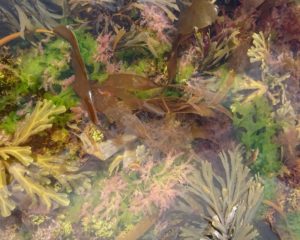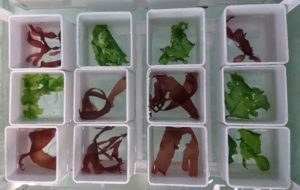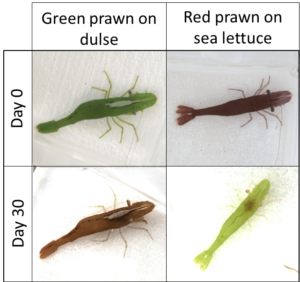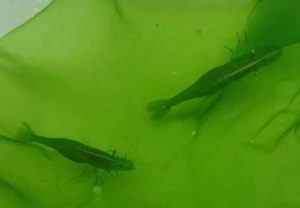Camouflage is vital to an animals survival, blending in to the background can stop you being spotted by predators or conversely, allow you to sneak up on your prey. But how do animals that live in highly variable environments like rockpools, where the surrounding plant life and available hide-y holes can change from one tide to the next, stay camouflaged? One option to has a variety of colour morphs like the chameleon prawn found in UK rockpools, but what happens if you suddenly find yourself in a pool predominately full of green seaweed when you are bright red?
University of Exeter PhD student Sam Green tells us about his new paper with the Sensory Ecology Evolution Group, working to understand the drivers of variation in the chameleon prawn colour variation.

Words by Sam Green, PhD Student, University of Exeter.
Key findings: Brightly coloured and aptly named chameleon prawns (Hippolyte varians) combine impressive changes in colour with behavioural preferences for particular seaweeds to survive in their rock pool habitats.
Here in Cornwall we are lucky to have easy access to incredibly diverse rock pools around our coastline that are teaming with wildlife. One fascinating species dwelling amongst the seaweeds close to the low tide line is the chameleon prawn (Hippolyte varians). An apt name for a species that is highly variable in appearance and found in forms ranging from vibrant red and green colours to varying degrees of transparency and patterning1,2. But what is driving this remarkable variation?

Rock pools are extremely beautiful and colourful environments but they are challenging to live in. Every day the tides’ ebb and flow, which changes the availability of submerged habitat as well as the varieties of predators that range over the rock pools looking for an easy meal. Could this variation in colour help prawns to avoid the interests of hungry fish? One possibility is that prawn coloration provides camouflage against their seaweed substrates. But how can they maintain this camouflage when the rock pool environment is so variable and always changing?

One remarkable camouflage strategy that might be used is for an animal to change body coloration itself. This is surprisingly common in the natural world with the duration of change ranging from a few seconds to weeks and months3. The well-known masters of this strategy include octopus and cuttlefish, where many are capable of swift changes to their coloration enabling them to quickly tailor their camouflage to the surroundings4. Might chameleon prawns also utilise colour change to better match their surroundings?
In our research we have focused on green and red chameleon prawns and their seaweed substrates, the green sea lettuce and red dulse. We brought prawns and seaweed into the lab and housed the prawns on seaweed of opposing coloration. Then, analysing coloration of prawns and seaweed from the perspectives of predatory fish visual systems, we measured changes in colour in relation to camouflage.

Prawns have an excellent level of camouflage against their associated substrate types. They are also capable of impressive, if somewhat slow, colour changes that drastically improve camouflage against the previously mismatching seaweed over a number of weeks. So the prawns can change colour, but it’s clearly too slow to maintain camouflage when swimming around the rock pools. The seaweeds that comprise the ‘algal forests’ of the intertidal zone vary with the seasons5. These slower colour changes probably enable prawns to capitalise on seasonal seaweed shifts, whilst still benefiting from the protection of camouflage. If this is the case, how do the prawns maintain camouflage on a day-to-day basis?

Animals often improve their camouflage through behaviour, such as choosing appropriate backgrounds that maximise their camouflage6. Again using the same two species of seaweed we tested the behavioural preferences of green and red chameleon prawns. The prawns display strong behavioural preferences for selecting a background that best compliments their own coloration. So, whilst colour change may be of no use if a passing wave were to dislodge a prawn from its chosen camouflaged perch, they are able to quickly rectify the issue by swimming to the nearest patch of suitable seaweed.

The act of remaining camouflaged is rarely as simple as it first appears. The incredible variation in body coloration displayed by chameleon prawns enables the highest level of camouflage against particular seaweed backgrounds. On top of that the prawns display clear adaptations for remaining obscured in their environment, despite the challenges presented by their rock pool existence. For the chameleon prawns, our research shows that perhaps the best way of maintaining camouflage in the face of variation is to have a suite of strategies to suit the occasion.

You can follow Sam on Twitter: @saunteringsam and Instagram: @saunteringsam
You can also keep up to date with the Sensory Ecology and Evolution Lab on Instagram: @See_research_lab and Facebook
References:
- Gamble, F. W. & Keeble, F. W. Hippolyte varians: a Study in Colour-change. Q. J. Microse Sci. 43, 589–703 (1900).
- Keeble, F. W. & Gamble, F. W. The colour-physiology of Hippolyte varians. Proc. R. Soc. London 65, 461–468 (1899).
- Duarte, R. C., Flores, A. A. V, Stevens, M. & Stevens, M. Camouflage through colour change : mechanisms , adaptive value and ecological significance. (2017). doi:10.1098/rstb.2016.0342
- Hanlon, R. Cephalopod dynamic camouflage. Curr. Biol. 17, 400–404 (2007).
- Dickinson, C. British Seaweeds – The Kew Series. (Eyre & Spottiswood, 1963).
- Stevens, M. & Ruxton, G. D. The key role of behaviour in animal camouflage. Biol. Rev. (2018). doi:10.1111/brv.12438
#ExeterMarine is an interdisciplinary group of marine related researchers with capabilities across the scientific, biological, medical, engineering, humanities and social science fields.
Find us on: Facebook : Twitter : Instagram : LinkedIn
If you are interested in working with our researchers or students, contact Michael Hanley or visit our website!

